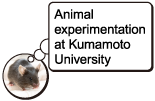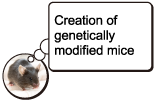Animal management
Regarding animal management methods, please refer to the following.Staff manage experimental animals to prevent infection with disease so that correct experimental data can be obtained quickly.
Animal care area divisions
The Animal Facility is divided as shown below. The isolation level for pathogenic microorganisms is different for each area.The area on the right has a high isolation level and strict care is required in regards to use.
Conventional area < SPF area < Infection experiments area < Isolator chamber
For details, please refer here.
Animal care management
Each area in which animals are cared for is kept clean by Animal Facility staff who give food and water, change cages, and apply disinfectant.The management policies common to each area are listed below.
- Feed
The feed used is prepared at the Animal Facility. It is replenished weekly by Animal Facility staff when cages are changed. - Water
UV-treated water is used (for automatic water supply). - Changing cages
Sterile bedding and cages are used and cages are changed every week (for mice and rats).
At the same time, animal health is observed and animals are checked for signs of any suffering due to serious infections.
- Cleaning
The animal care room is wiped down with disinfectant weekly at the same time that cages are changed.
The halls of the Animal Facility are also regularly wiped down. - Environment
In regards to the environment (such as temperature and humidity) provided by facility equipment, see here for details. - Estimation of animal care expenses
In order to calculate costs for animal care support by facility staff such as changing cages, etc. (animal care management duties), the number of cages used by researchers is checked daily.
Consultations regarding changes to animal care style or special feeding methods should be addressed to facility staff or to the following email address.
cardadmi
->Contact List (Internal University use only)
Regulation of pathogenic microorganisms
Monitoring
Infection of facility animals is monitored according to the following steps.- Inspection of monitored animals (for mice)
- Initial inspection and quarantine of received and unloaded animals.
- Observation of clinical symptoms during care management of large animals
- Observation by facility staff during animal care management
- Quarantine of cells and biological formulations brought to the Animal Facility
Main inspected items
| Mice | Rats | Dogs | Monkeys | Cells | Inspection methods (Inspected area) |
Inspection frequency | |
| Mycoplasma pulmonis |
Yes | Yes | − | − | − | ELISAa/IFAb (blood samples), cultures (trachea, laryngopharynx) | 12d |
| Bordetella bronchiseptica |
− | Yes | − | − | − | cultures (trachea, laryngopharynx) | 4 |
| Brucella canis |
− | − | Yes | − | − | cultures (blood) | upon arrival only |
| CAR bacillus |
Yes | Yes | − | − | − | ELISA/IFA (blood sample) | 1 |
| Citrobacter rodentium |
Yes | − | − | − | − | cultures (Caecal content) | 4 |
| Clostridium piliforme |
Yes | Yes | − | − | − | ELISA/IFA (blood sample) | 12 |
| Corynebacterium kutscheri |
Yes | Yes | − | − | − | cultures (trachea, laryngopharynx, Caecal content) | 4 |
| Helicobacter hepaticus |
Yes | − | − | − | − | PCRc (feces) | 4 |
| Pasteurella pneumotropica |
Yes | − | − | − | − | cultures (trachea/laryngopharynx, vaginal swab) | 4e |
| Pseudomonas aeruginosa |
Yes | Yes | − | − | − | cultures (Caecal content) | 4e |
| Salmonella spp. |
Yes | Yes | − | Yes | − | cultures (Caecal content, feces (monkeys)) | 4(monkeys: when needed) |
| Staphylococcus aureus |
Yes | − | − | − | − | cultures (Caecal content) | 4e |
| Streptococcus pneumoniae |
− | Yes | − | − | − | cultures (trachea/laryngopharynx) | 4 |
| B virus |
− | − | − | Yes | − | ELISA (blood sample) | outsourced upon arrival only |
| Ectromelia virus |
Yes | ー | − | − | − | ELISA/IFA (blood sample) | 4 |
| Lymphocytic chorimeningitis virus |
Yes | Yes | − | − | − | IFA (blood sample) | 1 |
| Mouse adenovirus |
Yes | Yes | − | − | − | ELISA/IFA (blood sample) | 4 |
| Mouse hepatitis virus・SDAV |
Yes | Yes | − | − | Yes | ELISA/IFA (blood sample), PCR (feces, cells) | 12 |
| Pneumonia virus of mice |
Yes | Yes | − | − | − | ELISA/IFA (blood sample) | 1 |
| Sendai virus |
Yes | Yes | − | − | − | ELISA/IFA (blood sample) | 12 |
| Aspiculuris tetraptera |
Yes | − | − | − | − | Microscopic examination (colon contents) | 12 |
| Syphacia spp. |
Yes | Yes | − | − | − | Microscopic examination (Perianal region) | 12 |
| Giardia muris |
Yes | Yes | − | − | − | Microscopic examination (Duodenal content) |
12 |
| Spironucleus muris |
Yes | Yes | − | − | − | Microscopic examination (Duodenal content) |
12 |
| Trichomonas spp. |
Yes | Yes | − | − | − | Microscopic examination (Caecal content) | 12 |
| Ectoparasite |
Yes | Yes | − | − | − | Microscopic examination (fur) | 12 |
| Parasite eggs | − | − | Yes | Yes | − | Flotation method, Microscopic examination (feces) | when needed |
| Heartworm microfilaria | − | − | Yes | − | − | Microscopic examination (blood) | upon arrival only |
| Dermatophytic fungi | Yes | Yes | − | − | − | cultures (fur) | when needed |
| a: enzyme antibody method, b: indirect fluorescent antibody method, c: polymerase chain reaction, d: times/year, e: immunodeficient mice only | |||||||
Division in charge
The Division of Microbiology and Genetics is responsible for inspection of pathogenic microorganisms.Please contact the supervisor below with questions regarding health inspection of animals during experiments, health inspection of animals other than mice, disclosure of period inspection results for mice, etc.
Supervisor: Nakamura
nanakamu
->Contact List (Internal University use only)
NEWS
- New web site is opened.
2016.03.31
SUPPORT
ACTIVITIES
STAFF
Kumamoto University
Institute of Resource Development and Analysis
Center for Animal Resources and Development
〒860-0811
2-2-1 Honjo, Chuo-ku, Kumamoto-shi
TEL :096-373-6550
FAX :096-373-6552
Email :mimura(a)kumamoto-u.ac.jp
Liaison:Imura
Contact List (Internal University use only)
Institute of Resource Development and Analysis
Center for Animal Resources and Development
〒860-0811
2-2-1 Honjo, Chuo-ku, Kumamoto-shi
TEL :096-373-6550
FAX :096-373-6552
Email :mimura(a)kumamoto-u.ac.jp
Liaison:Imura
Contact List (Internal University use only)


















